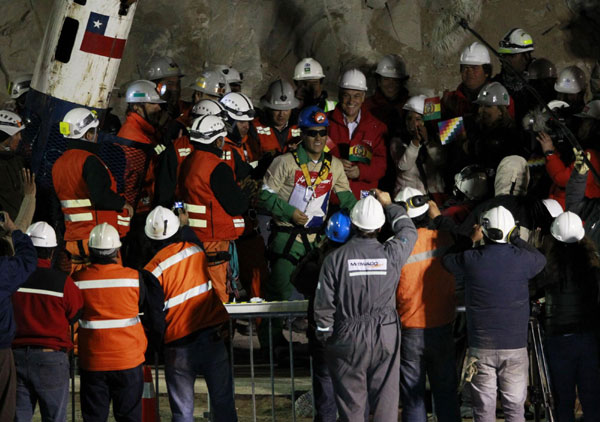Global General
4th man rescued from Chilean mine
(Xinhua)
Updated: 2010-10-13 15:20
 |
Large Medium Small |
 Bolivian miner Carlos Mamani celebrates after arriving as the fourth miner to be hoisted to the surface in Copiapo on Oct 13, 2010. [Photo/Agencies] |
SAN JOSE MINE, Chile - Bolivian Carlos Mamani became the 4th miner rescued from the San Jose mine when the capsule that lifted him up was brought back to surface early Wednesday morning.
Mamani was the only non-Chilean worker among the 33 miners who had been trapped 700 meters underground for 69 days.
Mamani worked at the mine only five days before it collapsed on Aug 5. The mine is located near the city of Copiapo, 800 km north of the capital city of Santiago.
Rescue efforts to pull out 33 miners trapped for over two months in a copper mine in northern Chile are still under way.
10 Major Steps of the Final Rescue Phase
Step 1: Rescue capsule tests
The Phoenix One Capsule, the largest in a series of three rescue capsules whose names symbolize rebirth, caused no major rocks to collapse during its test trip to and from 610 meters deep down into the tunnel, which inspired confidence in the following rescue process.
Step 2: Rescuers sent into the tunnel
A group of four rescue workers, including two nurses, entered the 622-meter-deep rescue tunnel on the Phoenix Two Capsule one by one on Tuesday night. Each descent took some 10 minutes, and another 10 minutes were needed for preparation.
Step 3: Miners enter the capsule
Starting midnight Tuesday, the miners are being lifted up one by one according to an official roster. The capsule, carrying one miner each time, will ascend through the 622-meter shaft to the ground
When they are being hoisted, each miner will be equipped with specially designed water- and sweat-proof mesh fabric clothes and sunglasses. Oxygen masks and medical belts that help monitor the miners' vital signs will also be crucial during each ascent.
Step 4: Miners to be lifted out
Each miner will be strapped into the rescue capsule, which is 3.95 meters in length and weighs 460 kg.
The microphone in the capsule and the loudspeaker on the miners' helmets will keep them in constant contact with the rescue team overground.
Miners can loosen the safety belts and open the doors on the capsule to return to where they were along with the sling if the rescue cage gets stuck during the upward trip.
Step 5: Initial body check-up
The rescued miners will be sent to doctors and nurses for an initial check-up, which is estimated to take 15-20 minutes.
Step 6: Detailed physical examination
The miners will be later sent to a field hospital where four doctors will observe their teeth and psychological conditions. There, they will also receive normal saline and vitamin D injections due to a long absence of light.
The whole physical check-up is estimated to take between 1.5 to 2 hours.
Step 7: Shower and short meeting with family members
Three shower nozzles have been prepared for the rescued miners so they can take their first shower in over two months. Meanwhile, eager family members are allowed to have a brief reunion with the miners at a makeshift rest area where there are chairs, tables and beds.
Each meeting can last for no more than 10 minutes.
Step 8: Flying to Copiapo
The rescued miners, four in each group, will be flown to the nearby city of Copiapo, 800 km north of the capital Santiago aboard a pair of Bell-412 helicopters.
Step 9: Visit to hospital
Upon arriving in Copiapo, the miners will be taken to local hospitals, where tailor-made beds will be waiting for them after a 5-7 minute ride in an ambulance.
The Chilean Security Association will then provide six months of psychological guidance to the saved miners.
Step 10: Strict control on patient visit
Family members are allowed to visit the saved miners for 45 to 90 minutes each day during the treatment period.



